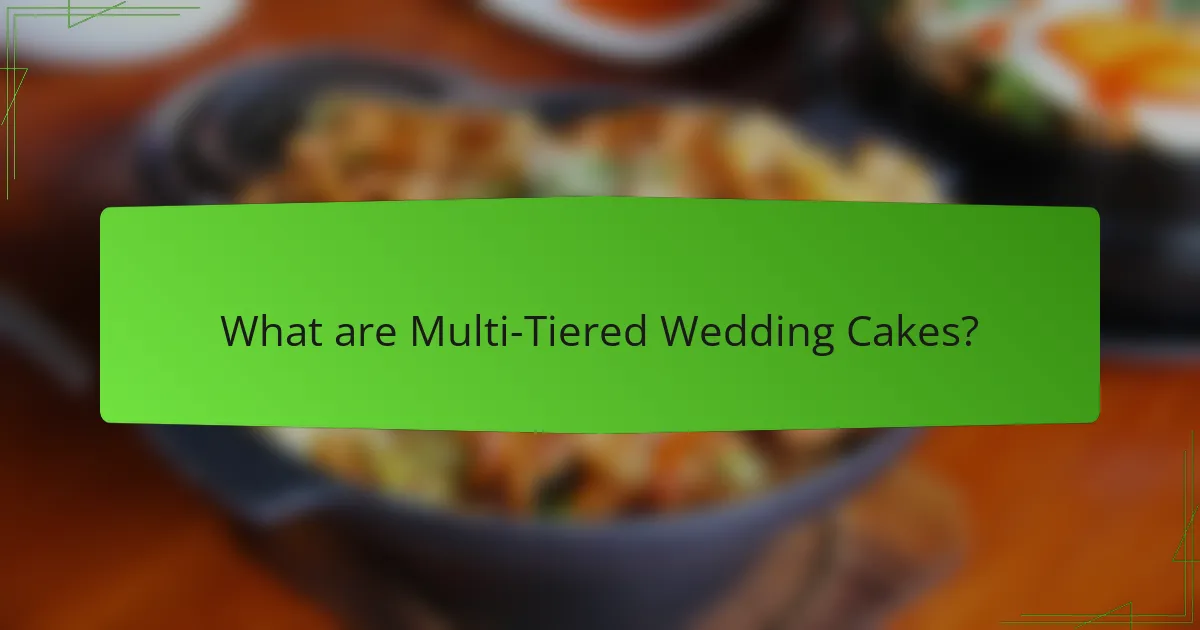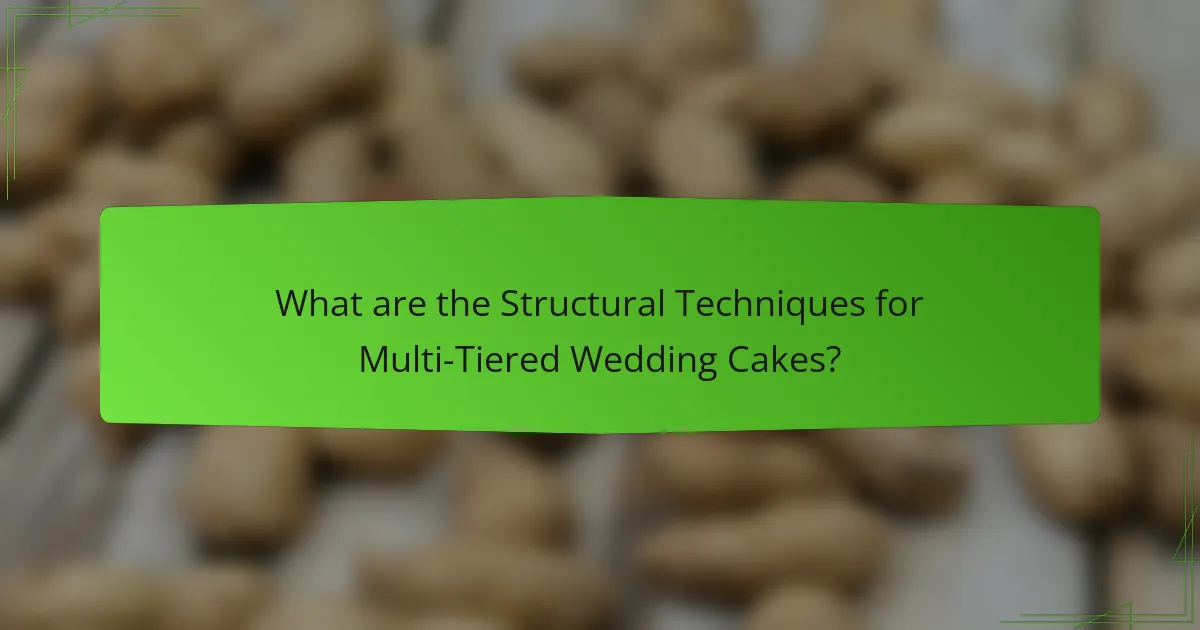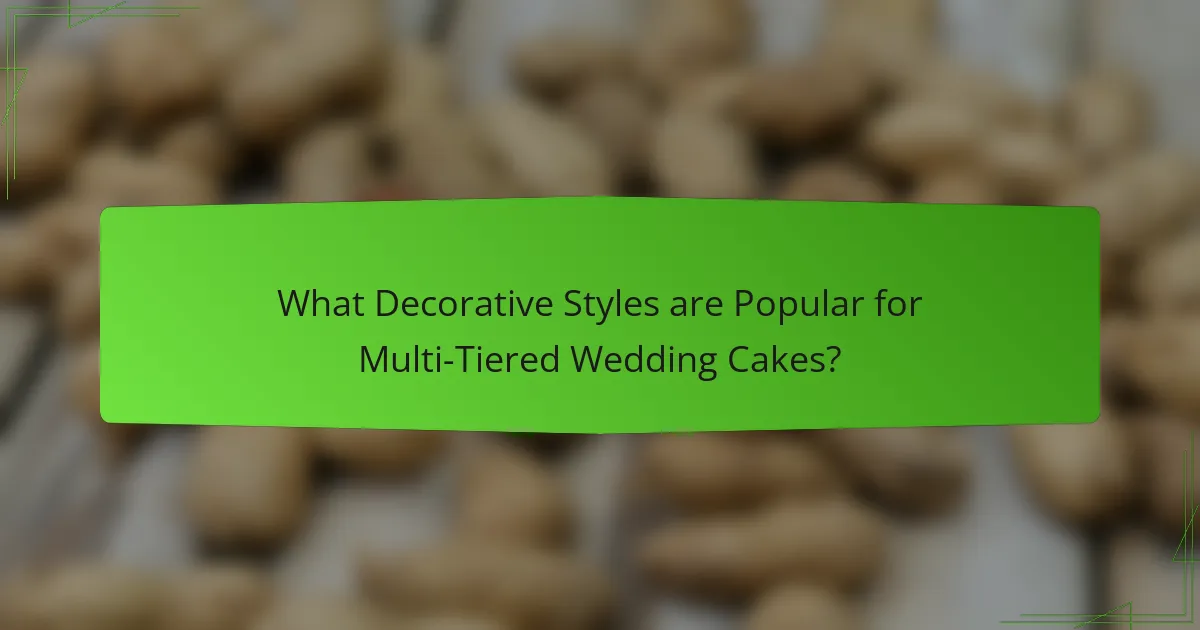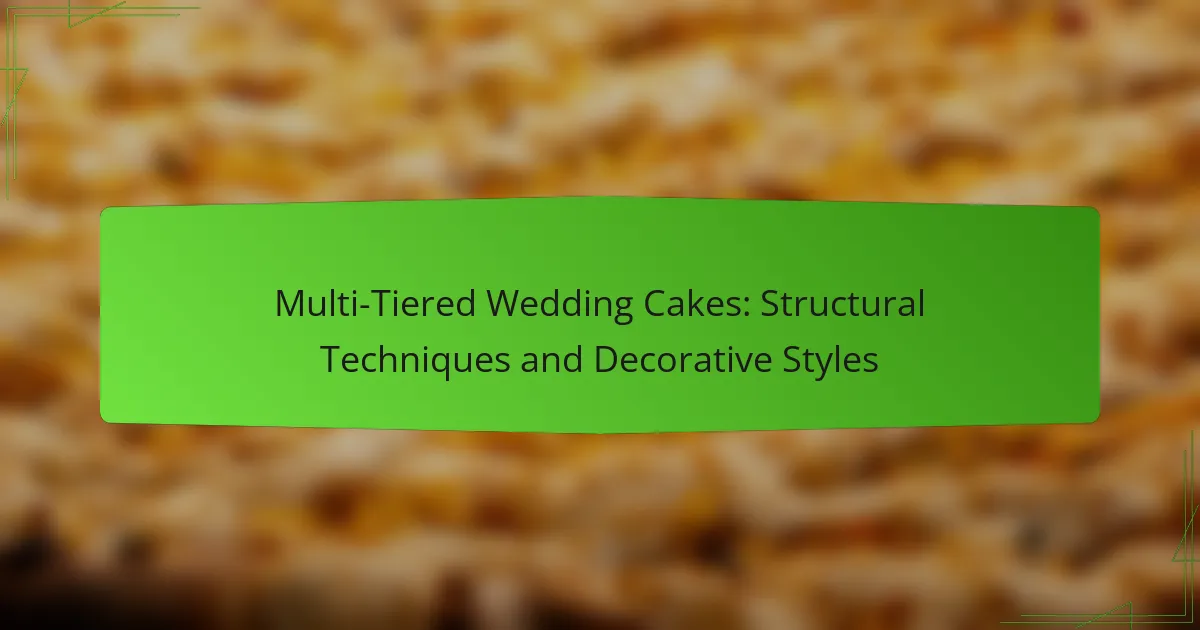
What are Multi-Tiered Wedding Cakes?
Multi-tiered wedding cakes are cakes composed of two or more stacked layers. These cakes are often designed for weddings to serve multiple guests. Each tier can vary in flavor, size, and decoration. Multi-tiered cakes are typically supported by dowels or pillars to maintain structural integrity. The design can incorporate intricate decorations, such as fondant, flowers, or edible lace. These cakes symbolize celebration and are often a focal point at wedding receptions. The tradition of multi-tiered cakes dates back to the 19th century in England, where they represented wealth and social status.
How are Multi-Tiered Wedding Cakes constructed?
Multi-tiered wedding cakes are constructed by stacking multiple layers of cake on top of each other. Each layer is typically baked separately and can vary in flavor and size. To ensure stability, a sturdy base layer is often used. Dowels or supports are inserted into the lower tiers to bear the weight of the upper layers. Frosting or fondant is applied to each tier for decoration. The cakes are then assembled on-site to prevent damage during transport. This method allows for intricate designs and height variations. Proper construction techniques are essential for both aesthetics and structural integrity.
What materials are commonly used in Multi-Tiered Wedding Cakes?
Common materials used in multi-tiered wedding cakes include cake layers, frosting, and structural supports. Cake layers are typically made from flour, sugar, eggs, and butter. Frosting often consists of butter, sugar, and flavorings, providing both taste and decoration. Structural supports can include dowels, plates, and sometimes cardboard to stabilize the tiers. Additionally, fondant and gum paste are used for decorative elements. These materials are essential for both the aesthetic and structural integrity of the cake.
How do different construction techniques affect the stability of the cake?
Different construction techniques significantly affect the stability of a cake. Techniques such as doweling, stacking, and using cake boards enhance structural integrity. Doweling involves inserting support rods into the cake layers, distributing weight evenly. This prevents the top tiers from collapsing under pressure. Stacking cakes with equal-sized layers ensures balance and reduces the risk of tilting. Using sturdy cake boards provides a solid base for each tier, further stabilizing the structure. Additionally, the use of a central support system can bolster multi-tiered designs. These techniques collectively ensure that cakes maintain their shape and structural integrity during transport and display.
Why are Multi-Tiered Wedding Cakes popular for weddings?
Multi-tiered wedding cakes are popular for weddings due to their visual appeal and tradition. They create a stunning centerpiece for the reception. The height of the cake adds elegance and sophistication to the event. Multi-tiered cakes can serve a larger number of guests, accommodating varying guest lists. They allow for creative designs and flavors, offering couples customization options. Historically, tiered cakes symbolize prosperity and good fortune in marriage. The tradition dates back to the Victorian era when elaborate cakes became fashionable. This historical significance adds to their desirability for modern weddings.
What cultural significance do Multi-Tiered Wedding Cakes hold?
Multi-tiered wedding cakes symbolize prosperity, unity, and celebration in various cultures. They often represent the couple’s social status and commitment to each other. Historically, these cakes were made with rich ingredients, indicating wealth and abundance. In many cultures, the number of tiers can signify different meanings, such as fertility or harmony. The act of cutting the cake is a ritual that symbolizes the couple’s first task together. This tradition dates back to ancient Rome, where a cake was broken over the bride’s head for good fortune. Multi-tiered cakes are also a focal point at wedding receptions, enhancing the festive atmosphere. Their elaborate designs reflect personal stories and cultural heritage, making them unique to each couple.
How do Multi-Tiered Wedding Cakes enhance the wedding experience?
Multi-tiered wedding cakes enhance the wedding experience by serving as a central visual focal point. Their elaborate designs create a stunning centerpiece that captures guests’ attention. The variety of flavors and fillings across tiers allows for diverse taste experiences. This caters to different preferences among guests, enhancing overall satisfaction. Multi-tiered cakes also symbolize abundance and celebration, reinforcing the joyous occasion. Statistically, 90% of couples consider the wedding cake an essential element of their wedding. This highlights its significance in the wedding experience. The cake cutting ceremony adds a memorable moment for the couple and guests alike. Overall, multi-tiered wedding cakes contribute to the aesthetic, flavor, and emotional aspects of the celebration.

What are the Structural Techniques for Multi-Tiered Wedding Cakes?
Structural techniques for multi-tiered wedding cakes include the use of dowels, cake boards, and support systems. Dowels provide stability by acting as internal supports for each tier. Cake boards serve as a base for each tier, distributing weight evenly. A central support rod can be used for taller cakes, enhancing stability. Additionally, stacking techniques involve careful alignment to prevent slippage. These methods ensure that the cake maintains its shape and structure during transport and display. Proper use of these techniques minimizes the risk of tier collapse, which is critical for successful multi-tiered cakes.
What are the common structural techniques used in Multi-Tiered Wedding Cakes?
Common structural techniques used in multi-tiered wedding cakes include doweling, cake boards, and internal supports. Doweling involves inserting wooden or plastic rods into the cake layers to provide stability. This technique prevents the upper tiers from collapsing under the weight of the lower ones. Cake boards are placed between tiers to distribute weight evenly. They also serve as a sturdy base for each layer. Internal supports, such as pillars or straws, can be used to further stabilize the structure. These techniques are essential for ensuring that multi-tiered cakes remain intact during transport and display.
How does the support system influence the design of Multi-Tiered Wedding Cakes?
The support system significantly influences the design of multi-tiered wedding cakes. It determines the stability and height of the cake. A robust support system allows for taller designs without risk of collapse. Common support systems include dowels, plates, and central pillars. These components distribute weight evenly across tiers. Properly installed supports prevent shifting during transport and display. The choice of support also affects the cake’s aesthetic appeal. Decorative elements can be integrated with the support system for enhanced visual impact. Overall, a well-designed support system is crucial for both functionality and style in multi-tiered wedding cakes.
What role does cake board placement play in the structure?
Cake board placement is crucial for the structural integrity of multi-tiered wedding cakes. It provides a stable foundation for each layer, distributing weight evenly. Proper placement prevents sagging and collapse during display and transport. Cake boards also facilitate easier handling and serving of individual tiers. They act as a barrier, protecting the cake from direct contact with surfaces. Additionally, cake boards can enhance the aesthetic appeal by allowing for decorative designs. Using the correct thickness and size of cake boards further strengthens the overall structure. This ensures that the cake maintains its shape and elegance throughout its lifecycle.
How can structural techniques affect the overall design?
Structural techniques significantly influence the overall design of multi-tiered wedding cakes. These techniques ensure stability and support for the cake’s weight. Proper structural methods prevent tier collapse during assembly and transportation. For instance, dowels and cake boards are commonly used to distribute weight evenly. The choice of materials can also affect the cake’s aesthetic appeal. Stronger supports allow for more intricate designs and heavier decorations. Additionally, structural techniques can dictate the cake’s height and tier arrangement. Effective use of these techniques can enhance both functionality and visual impact.
What are the best practices for ensuring stability in tall cakes?
To ensure stability in tall cakes, use proper support structures. Incorporate dowels or straws in each tier to distribute weight evenly. Choose a sturdy base board to support the entire cake. Use a firm cake recipe that holds its shape well. Frost the cake with a thick layer of buttercream or fondant to seal in moisture and provide additional stability. Stack the tiers carefully, aligning them properly to avoid leaning. Secure the tiers with a central dowel for added support. These practices help maintain the cake’s integrity during transportation and display.
How do different tier arrangements impact the cake’s structural integrity?
Different tier arrangements significantly impact a cake’s structural integrity. The arrangement affects weight distribution and stability. A wider base tier supports the upper tiers better than a narrow one. Stacking tiers without proper support can lead to collapse. Using dowels or supports between layers enhances stability. Uneven tier arrangements increase the risk of tipping. Cakes with a central support system are less prone to structural failure. Proper tier arrangement is crucial for maintaining overall cake integrity during transport and display.

What Decorative Styles are Popular for Multi-Tiered Wedding Cakes?
Popular decorative styles for multi-tiered wedding cakes include classic, modern, rustic, and themed designs. Classic styles often feature intricate piping and floral decorations. Modern styles may incorporate geometric shapes and minimalistic designs. Rustic cakes usually showcase natural elements like wood and fresh flowers. Themed designs reflect the couple’s interests or wedding theme. Each style enhances the visual appeal of the cake while aligning with wedding aesthetics.
What are the trending decorative styles for Multi-Tiered Wedding Cakes?
Trending decorative styles for multi-tiered wedding cakes include [censured] cakes, floral designs, and geometric patterns. [censured] cakes showcase exposed layers with minimal frosting. Floral designs incorporate fresh or sugar flowers for a romantic touch. Geometric patterns use sharp lines and shapes for a modern aesthetic. Metallic accents, such as gold or silver leaf, add elegance. Watercolor effects provide a soft, artistic appearance. Ombre designs transition colors smoothly across tiers. Finally, personalized cake toppers reflect the couple’s unique story. These styles are popular for their visual appeal and customization options.
How do color schemes influence the aesthetics of the cake?
Color schemes significantly influence the aesthetics of a cake. They affect the visual appeal and overall perception of the cake. A well-chosen color palette can enhance the theme of an event. For example, soft pastels may evoke a romantic feel, while bold colors can create a vibrant atmosphere. Color combinations can also highlight specific cake features, such as intricate designs or textures. Studies show that color can impact emotions and preferences. This means that the right colors can make a cake more desirable. Ultimately, color schemes play a crucial role in cake design and presentation.
What types of embellishments are commonly used in cake decoration?
Common embellishments used in cake decoration include fondant, buttercream, and edible flowers. Fondant provides a smooth finish and can be molded into shapes. Buttercream is versatile and can be piped into various designs. Edible flowers add a natural touch and visual appeal. Other embellishments include sprinkles, chocolate ganache, and fruit. Sprinkles offer color and texture, while ganache adds richness. Fruit can enhance flavor and presentation. These embellishments contribute to the overall aesthetic of multi-tiered wedding cakes.
How can personalized touches enhance the decorative style?
Personalized touches enhance the decorative style of multi-tiered wedding cakes by adding unique elements that reflect the couple’s identity. These touches can include custom colors, monograms, or specific floral arrangements. Incorporating personal stories or themes makes the cake more meaningful. For example, a couple might choose flavors that represent their favorite desserts. This approach creates a visually appealing centerpiece that resonates with guests. Studies show that personalized decorations can increase guest satisfaction at events. Personalization elevates the overall aesthetic, making the cake a memorable focal point.
What are some unique decoration ideas for themed weddings?
Unique decoration ideas for themed weddings include using custom backdrops that reflect the theme. For a vintage theme, consider lace draping and antique furniture. A beach theme can feature seashells and driftwood centerpieces. For a fairy tale theme, incorporate twinkling fairy lights and enchanted forest elements. A rustic theme may use burlap table runners and mason jar candles. Each decoration idea enhances the overall atmosphere and aligns with the chosen theme. The effectiveness of these ideas is supported by their popularity in recent wedding trends, showcasing their appeal to couples.
How can couples incorporate their personal stories into the cake design?
Couples can incorporate their personal stories into cake design by using custom decorations that reflect significant moments. Personal elements like favorite colors, symbols, or quotes can be integrated. For example, a couple might choose a floral design that represents their first date location. They can also use edible images that showcase memorable experiences. Unique flavors representing shared tastes can be included in the cake layers. Additionally, couples can select a cake topper that symbolizes their journey together. These personalized touches create a meaningful connection to their story. Each design element can evoke memories and emotions, enhancing the overall wedding experience.
What are the best practices for decorating Multi-Tiered Wedding Cakes?
The best practices for decorating multi-tiered wedding cakes include ensuring structural stability, using quality ingredients, and balancing aesthetics. First, support each tier with dowels or a cake board to prevent collapse. Second, choose a cake recipe that holds its shape well, such as a dense buttercream or fondant. Third, apply a crumb coat to seal in crumbs before the final icing layer. Fourth, use fondant or ganache for a smooth finish, as they provide a polished look. Fifth, incorporate decorations that complement the wedding theme, such as fresh flowers or edible gold leaf. Lastly, ensure the decorations are proportionate to the cake size for visual harmony. These practices enhance both the appearance and integrity of the cake.
How can decorators ensure consistency in design across tiers?
Decorators can ensure consistency in design across tiers by using uniform color palettes and design motifs. Consistent color choices help create a cohesive look. Repeating design elements, such as floral arrangements or patterns, reinforces this unity. Standardizing the size and shape of tiers also contributes to a balanced appearance. Additionally, decorators can apply the same techniques for frosting and embellishments on each tier. For example, if a specific piping technique is used on one tier, it should be replicated on all others. This approach maintains visual harmony throughout the cake. By following these practices, decorators can achieve a seamless and elegant multi-tiered wedding cake design.
What tips can help achieve a professional finish on a wedding cake?
To achieve a professional finish on a wedding cake, ensure a smooth base layer. Use a crumb coat to seal in loose crumbs before applying the final layer of frosting. Choose high-quality ingredients for both cake and frosting to enhance taste and appearance. Level each cake layer to create even tiers, which contributes to the overall aesthetic. Use fondant for a sleek, polished look, as it can be rolled out to a uniform thickness. Invest in proper tools, such as a bench scraper and offset spatula, for clean edges and surfaces. Decorate with fresh flowers or edible embellishments for a sophisticated touch. Finally, keep the cake in a cool environment to maintain its integrity and appearance until serving.
Multi-tiered wedding cakes are elaborate desserts composed of multiple stacked layers, designed to serve numerous guests at weddings. This article explores the structural techniques essential for their stability, such as doweling and cake board placement, as well as popular decorative styles that enhance their visual appeal. Additionally, it examines the cultural significance and historical roots of these cakes, highlighting their role as a centerpiece in wedding celebrations. The discussion includes best practices for achieving a professional finish and incorporating personalized elements into the cake design, ensuring a memorable experience for couples and their guests.
